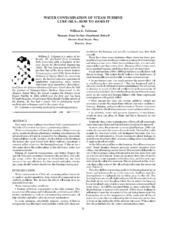| dc.contributor.other | Turbomachinery Symposium (17th : 1988) | |
| dc.creator | Coleman, William L. | |
| dc.date.accessioned | 2017-10-05T14:29:04Z | |
| dc.date.available | 2017-10-05T14:29:04Z | |
| dc.date.issued | 1988 | |
| dc.identifier.uri | https://hdl.handle.net/1969.1/163605 | |
| dc.description | Lecture | en |
| dc.description | Pg. 51-56 | en |
| dc.description.abstract | Ever since steam turbines have been built, contamination of the lube oil by water has been a persistent problem. Water contamination will result in rusting of ferrous components, accelerate sludging leading to sticking of mechanisms. In advanced cases, if water is pumped by the oil pump, immediate bearing failures result. Aeration of oil as it leaves the bearing is the reason why most forced feed (lube) turbines experience a constant in flow of air into the bearing housings. If this air has a dew point above the coolest place in the oil system, water contamination results. Raising oil reservoir temperatures and better flingers frequently help and sometimes eliminates the problem, but a dry gas purge, either dry nitrogen or dehydrated air, has been proven to be very effective. For best results and safety, the dry gas purge should be introduced into the bearing housing seal. | en |
| dc.format.medium | Electronic | en |
| dc.format.mimetype | application/pdf | |
| dc.language.iso | en | |
| dc.publisher | Texas A&M University. Turbomachinery Laboratories | |
| dc.relation.ispartof | Proceedings of the 17th Turbomachinery Symposium | en |
| dc.subject.lcsh | Turbomachines | en |
| dc.title | Water Contamination Of Steam Turbine Lube Oils - How To Avoid It. | en |
| dc.type.genre | Presentation | en |
| dc.type.material | Text | en |
| dc.identifier.doi | https://doi.org/10.21423/R1S674 | |


